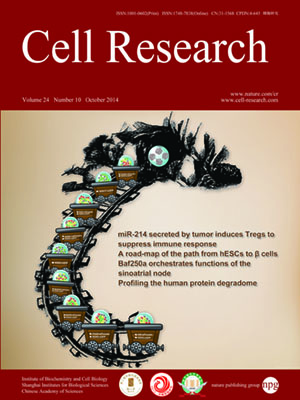
Volume 24, No 10, Oct 2014
ISSN: 1001-0602
EISSN: 1748-7838 2018
impact factor 17.848*
(Clarivate Analytics, 2019)
Volume 24 Issue 10, October 2014: 1201-1213 | Open Access
ORIGINAL ARTICLES
Baf250a orchestrates an epigenetic pathway to repress the Nkx2.5-directed contractile cardiomyocyte program in the sinoatrial node
Meng Wu1,2,*, Siwu Peng1,2,*, Jialiang Yang2, Zhidong Tu2, Xiaoqiang Cai1,3, Chen-Leng Cai1,3, Zhong Wang4 and Yong Zhao1,2
1Mindich Child Health and Development Institute, Icahn School of Medicine at Mount Sinai, One Gustave L. Levy Place, New York, NY 10029, USA
2Department of Genetics and Genomic Sciences, Icahn School of Medicine at Mount Sinai, One Gustave L. Levy Place, New York, NY 10029, USA
3Developmental and Regenerative Biology, Icahn School of Medicine at Mount Sinai, One Gustave L. Levy Place, New York, NY 10029, USA
4Department of Cardiac Surgery, Cardiovascular Research Center, University of Michigan, 2800 Plymouth Road, Ann Arbor, MI 48109, USA
Correspondence: Yong Zhao, Tel: +1-212-824-8916; Fax: +1-212-241-3310 E-mail: yong.zhao@mssm.edu; Zhong Wang, Tel: +1-734-763-3691; Fax: +1-734-763-3697(zhongw@med.umich.edu)
The sinoatrial node (SAN) is essential for rhythmic beating of the heart; however, our understanding of what controls proper functioning of the SAN remains primitive. To explore molecular control of SAN function, we specifically deleted Baf250a, a key regulatory component of the ATP-dependent chromatin remodeling complex SWI/SNF, in the SAN. Deletion of Baf250a in the SAN led to sinus bradycardia. Time series analysis of dysregulated genes after deletion of Baf250a reveals a transcriptional hierarchy maintaining pacemaker cell identity, i.e., Baf250a activates the expression of Tbx3, and Baf250a, Tbx3 and histone deacetylase 3 coordinately repress the expression of Nkx2.5. Disruption of this repressive pathway switches on expression of Nkx2.5, which stimulates expression of Gata4 and Tbx5. These three cardiac transcription factors further turn on a contractile cardiomyocyte program in the SAN, which eventually leads to sick sinus disease (SSD). Our study suggests that disruption of key genetic pathways regulating cardiac lineage segregation may cause SSD and cardiac arrhythmias in general.
10.1038/cr.2014.113
FULL TEXT | PDF
Browse 2096


